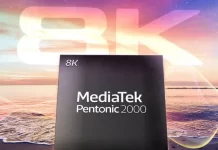Since only LG and Samsung make large OLED displays, comparing panels from LG and Samsung makes sense. Especially in 2024 when Samsung announced that it would buy LG panels for its OLED TVs of all available sizes. The TVs may use different OLED materials, but the focus will shift to usability and streaming services.
Structure of OLED displays
Samsung and LG’s display technologies operate on a similar principle involving OLED diodes that emit light. LG utilizes white organic diodes, while Samsung employs blue OLEDs. Both systems incorporate a layer of light filters that selectively allow red, green, and blue light to pass through.
Originally, OLED displays used colored organic diodes. However, this approach proved impractical due to the varying lifespans of different colored OLED materials, which led to rapid screen burn-in. Consequently, both companies adopted a more practical solution by using a single-color OLED layer and adding a layer of light filters to create the necessary colors. This approach mitigates the issue of differential aging and enhances the overall durability and performance of OLED displays.

Features of WOLED displays
LG has been producing OLED displays since 2016, releasing several generations over the years, with the latest featuring MLA (Micro Lens Array) technology. The term WOLED (White OLED) is sometimes explained differently: some attribute it to the white color of the self-emitting diodes, while others suggest it includes a fourth white subpixel.
The primary feature of these displays is the use of four subpixels—red, green, blue, and white—to create a single image point. This configuration offers several advantages:
- Extended Subpixel Lifespan: Using a white subpixel to create white light instead of combining red, green, and blue subpixels reduces wear and extends the lifespan of the subpixels.
- Reduced Power Consumption: Since fewer subpixels must be activated to produce white light, the overall power consumption is reduced by 30-40%, making LG’s OLED displays more energy-efficient.
There is a common misconception that including a white subpixel increases brightness. However, this is not the case; the white subpixel primarily serves to improve efficiency and longevity rather than brightness.
Increasing the brightness of LG’s WOLED displays
LG’s OLED TVs with the “EVO” prefix denote models with enhanced brightness capabilities. Initially, these EVO series TVs featured improved OLED materials that allowed for increased light output. In 2023, LG further advanced its display technology by introducing Multi-Lens Array (MLA) technology. This innovation boosts display brightness by 40% without increasing power consumption.
MLA technology works by incorporating a layer of microlenses near each subpixel. These microlenses redirect light that would otherwise be dispersed and absorbed within the display, directing it toward the viewer. This principle is akin to the historical practice of placing candles in front of mirrors to amplify their brightness. By efficiently channeling more light through the display, MLA enhances brightness without the need for additional power.
Samsung QD OLED TVs
Samsung first realized the idea of an OLED TV in 2013. However, the project eventually failed due to the TV’s high cost, problems with rapid burn-in, and frequent breakdowns. As a result, Samsung’s management shifted its focus to LED TVs and curtailed efforts to develop large OLED screens. Meanwhile, LG continued to develop its OLED technology and produce OLED TVs. Recognizing the potential of large OLED displays, Samsung eventually allocated funds to develop its OLED technology, albeit with a significant delay.
Samsung’s OLED features
Samsung chose a three-pixel sub-pixel structure with inherently higher brightness for its displays. This structure is designed to improve the brightness and image quality of Samsung’s displays compared to LG’s displays. Indeed, since white color is created by three subpixels with increased brightness, the image quality of Samsung displays is noticeably better. However, this advantage has disadvantages, such as higher power consumption to generate more intense light output. To cope with heat generation, Samsung OLED displays have a foil layer on the back that dissipates heat, preventing the screen from overheating.
The advent of LG WOLED panels with MLA technology has virtually equalized the image quality of WOLED and QD-OLED panels. However, Samsung TVs still show higher color brightness, second only in the white spectrum.
The battle for OLED TVs between LG and Samsung
When LG started manufacturing OLED displays, it adopted an open distribution policy. This strategy allowed any company to purchase OLED displays for their TVs, which allowed LG to take a leading position in the market. Samsung started producing OLED displays in 2022 and announced plans to start supplying displays to other manufacturers in 2023. Sony became the first company to contract with Samsung to supply QD-OLED panels for its TVs in 2023.
Despite this, Samsung must still ramp up OLED TV production to meet market demand. Recognizing the growth of the OLED TV market, Samsung has contracted to purchase about 1 million WOLED panels from LG for its TVs starting in 2024. The move aims to saturate the market with Samsung’s OLED TVs.
Conclusion of Samsung’s QD-OLED and LG’s WOLED

- Power Consumption: WOLEDs consume less power, which is particularly important for large TVs.
- Color Saturation: QD-OLEDs display more saturated colors. However, due to human perception’s peculiarities, most viewers may not notice this difference.
- White Spectrum: QD-OLEDs are inferior in rendering the white spectrum. On Samsung’s OLEDs, bright scenes with a lot of white can have a slight gray tint.
Overall, there is not much difference in image quality between QD-OLED and WOLED. Buyers’ competition will focus more on marketing and the usability of the operating systems. Recognizing the importance of marketing, in 2024, Samsung removed mentions of QD-OLED screens and did not highlight the use of WOLED displays in their products.





